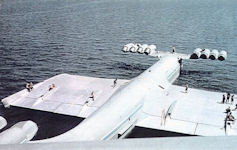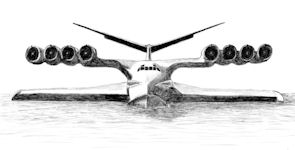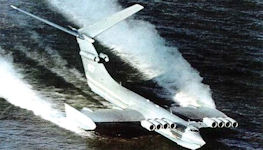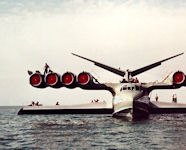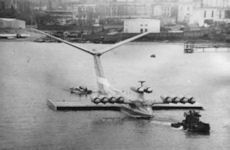KM KASP-A MD-160 Caspian Sea Monster
Project KM (known in the US as the Caspian Sea Monster) was a one-of-a-kind test vehicle with the purpose of demonstrating that ekranoplans of large size could be designed, constructed, and flown to theoretical performance levels. It was built in the early- to mid-1960s and flew until its crash and destruction in the early 1980s. Built in the mid-1960s, the 100-meter-long Caspian Sea Monster was the biggest ekranoplan of all time, weighing an impressive 544 tons. Despite the weight, the vehicle could lift heavier loads off the ground than any other plane at the time. It finally crashed due to fog and it was abandoned in water.The Caspian Sea Monster, officially «KM» (Korabl Maket, Russian - Experimental Craft), was also known as the "Kaspian Monster". KM means “Naval Ship Prototype”, not “Caspian Sea Monster”. There were at least eight modifications to the single craft built, the number on the tail indicating the modification number.
Raymond Garthoff reported that "First sighted next to a dock on the Caspian Sea littoral during 1958–61, the strange-looking, large aircraft was powered by four turbojet engines and modified with pontoons for sea duty. In 1966 a new and even larger seaplane was identified, also in the Caspian Sea. This truly monstrous newcomer was given the same name that had been bestowed on its predecessor. The new Caspian Sea Monster was flight tested in the autumn of 1966." The term Caspian Sea Monster came about when US satellites first spotted the large vehicle with stubby wings skimming over the waters of the Caspian Sea. Initially they thought it to be a prototype flying boat.
Garthoff notes that "... the CIA designation for the aircraft first test-flown in 1966, like the name given the earlier aircraft, derives from the location it was sighted and its strange appearance. The error appears to stem, at least in part, from the fact that all published discussions of the Caspian Sea Monster (at least all of the dozen I have been able to find, most included in Wikipedia) other than this article and Smith’s chapter in Watching the Bear refer only to the second giant hovercraft first identified in 1966, their authors evidently unaware of the existence of an earlier Caspian Sea Monster."
In 1966 the Central Hydrofoil Design Bureau under Rostislav Alekseev produced a gargantuan "ekranoplan" ("surface plane") combining the smooth hull form of a ship with stub wings, a large vertical fin and horizontal tail. The craft featured ten engines: eight mounted in two clusters of four directly behind the cockpit to provide augmented lift, and two on the vertical fin to provide cruise power. This machine, which American intelligence organizations dubbed the Caspian Sea Monster, could lift 540 tons and cruise at over 300 mph at an altitude of over 10 feet.
In the early 1960s, US spy satellites observed the Soviets building something huge on the shores of the Caspian Sea. When the Hexagon KH-9 cameras detected a new target of inter- est on the search mission, the NRO would precisely point Gambit KH-8 cameras at the area or object on the surveillance mission to give a high level of detail. Hexagon's capabilities enabled the system to capture “fleeting events of intelligence interest”, such as its inadvertent imaging on M1213 of a Soviet vessel, the KASP-B, being pulled by tugboats to an unknown location. Mostly because of Gambit imagery, U.S. intelligence had discovered this huge vessel with indeterminate mission in 1967 and dubbed the mysterious craft the “Caspian Sea Monster”.
Ten Dobrynin VD-7 turbojet engines propelled the KM, each generating 11,000 kg / 28,670 lbf of thrust. The eight engines mounted just aft of the cockpit were used to generate lift while the two tail mounted engines were designated as cruise engines. To increase the airflow under the wings, the jet exhaust can be directed downwards. On the front pylon housed 8 engines, their power was used mainly at the start. On the keel were two more of the same engine, sufficient to maintain the cruising mode. In the first flight, piloted winged Alexeev personally. The flight took about 50 minutes at a height of about 4 m. The tests were successful. In August of 1967, WIG KM flew weighing 544 tons, developing at the same speed of 455 km / h. It was an unofficial world record for aircraft of that time.
The KM was designed to cruise at 267 mph but with a maximum operational speed of 311 mph. During testing, the KM achieved 405 mph but a claimed speed of 460 mph was thought possible. These speeds were achieved at an altitude of 15-45 feet in order to utilize the ground effect. The KM could operate in a sea state up to 4 feet. On the model, the wing "flaps", the vertical stabilizer, and elevators on the high-mounted wing are all movable.
Ground effect is the reduced drag on a vehicle due to the interruption, by the surface, of air flowing from under its wings tips, around them, to their tops. When not interrupted, the air flowing to the top of the wings forms a high pressure area over the wings, pushing the vehicle downward. Today's aircraft use specially shaped wings and winglets on their tips to reduce the air flow. Prior to the discovery of the effects of specialized wing shapes and winglets, during the era of the Caspian Sea Monster, aircraft had to use more power to continue to fly at a given speed and not lose altitude when not in ground effect.
Ground effect vehicles, such as the Caspian Sea Monster, are more like hydrofoiles, and unlike hovercraft. Hovercraft must use the thrust of their engines pointed downward to lift them from the surface, in addition to horizontal thrust for forward motion. The engines of the Caspian Sea Monster propelled it forward to provide horizontal thrust only. By running at up to 2 meters above the surface, the Caspian Sea Monster was able to propel its huge mass at speeds up to 460 mph.
The Caspian Sea Monster needed to build up sufficient speed to get into ground effect. This could be complicated by rough seas. Not getting the vehicle into the air quickly enough could result in its nose being buried in a wave. Maneuvering the huge vehicle was about what you would expect. Responses to control inputs took a while, and were more like steering an ocean liner than an airplane. Reducing the speed of the Caspian Sea monster so that it would stop flying was like putting down very effective flaps on an aircraft. The drag of the water on the hull of the vehicle caused it to slow quickly. The ten turbojet engines of the Caspian Sea Monster used large quantities of fuel to fly the aircraft at cruising speed. Such a vehicle would not be practicle to operate with the high prices of fuel of today.
The tests took place at the Cabinet of the Caspian Sea for 15 years, but they have ended very sadly. In December 1980, the Cabinet on the fault of the crew, crashed and sank (the crew managed to escape). On the 20-meter shoal huge tail Monster 2 more weeks could be seen over the Caspian Sea.
| Wingspan, m | 37.60 / 122 feet |
| The scope of the tail, m | 37.00 |
| Length m | 92.00 / 399 feet |
| Height, m | 21.80 |
| Wing area, m2 | 662.50 |
| Weight, kg null | 240000 |
| maximum take-off | 544000 |
| engine's type | 10 turbojet WA-7 |
| Thrust, kgf | 11,000 x 10 |
| Maximum speed km / h | 500 |
| Cruising speed, km / h | 430 |
| Practical range, km | 1500 |
| Flight height on the screen, m | 4-14 |
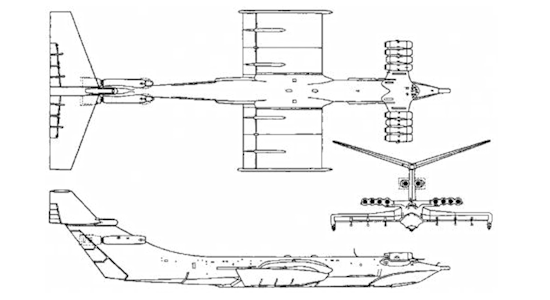
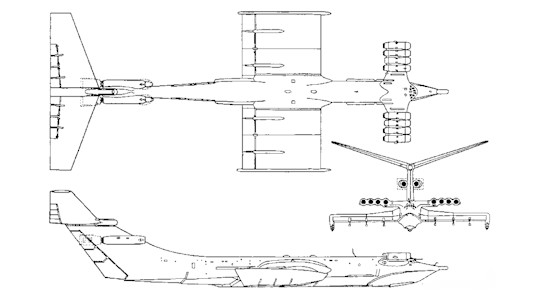
|
NEWSLETTER
|
| Join the GlobalSecurity.org mailing list |
|
|
|


